[English] 日本語
 Yorodumi
Yorodumi- EMDB-32212: Oligomeric interactions maintain active-site structure in a non-c... -
+ Open data
Open data
- Basic information
Basic information
| Entry |  | |||||||||
|---|---|---|---|---|---|---|---|---|---|---|
| Title | Oligomeric interactions maintain active-site structure in a non-cooperative enzyme family | |||||||||
 Map data Map data | ||||||||||
 Sample Sample |
| |||||||||
 Keywords Keywords | Rossman fold / tetramer / tag-free / wild type with NADPH / OXIDOREDUCTASE | |||||||||
| Biological species |  Candida parapsilosis (yeast) / Candida parapsilosis Candida parapsilosis (yeast) / Candida parapsilosis | |||||||||
| Method | single particle reconstruction / cryo EM / Resolution: 4.03 Å | |||||||||
 Authors Authors | Li YH / Zhang RZ / Wang C / Forouhar F / Clarke O / Vorobiev S / Singh S / Montelione G / Szyperski T / Xu Y / Hunt JF | |||||||||
| Funding support |  China, 2 items China, 2 items
| |||||||||
 Citation Citation |  Journal: EMBO J / Year: 2022 Journal: EMBO J / Year: 2022Title: Oligomeric interactions maintain active-site structure in a noncooperative enzyme family. Authors: Yaohui Li / Rongzhen Zhang / Chi Wang / Farhad Forouhar / Oliver B Clarke / Sergey Vorobiev / Shikha Singh / Gaetano T Montelione / Thomas Szyperski / Yan Xu / John F Hunt /   Abstract: The evolutionary benefit accounting for widespread conservation of oligomeric structures in proteins lacking evidence of intersubunit cooperativity remains unclear. Here, crystal and cryo-EM ...The evolutionary benefit accounting for widespread conservation of oligomeric structures in proteins lacking evidence of intersubunit cooperativity remains unclear. Here, crystal and cryo-EM structures, and enzymological data, demonstrate that a conserved tetramer interface maintains the active-site structure in one such class of proteins, the short-chain dehydrogenase/reductase (SDR) superfamily. Phylogenetic comparisons support a significantly longer polypeptide being required to maintain an equivalent active-site structure in the context of a single subunit. Oligomerization therefore enhances evolutionary fitness by reducing the metabolic cost of enzyme biosynthesis. The large surface area of the structure-stabilizing oligomeric interface yields a synergistic gain in fitness by increasing tolerance to activity-enhancing yet destabilizing mutations. We demonstrate that two paralogous SDR superfamily enzymes with different specificities can form mixed heterotetramers that combine their individual enzymological properties. This suggests that oligomerization can also diversify the functions generated by a given metabolic investment, enhancing the fitness advantage provided by this architectural strategy. | |||||||||
| History |
|
- Structure visualization
Structure visualization
| Supplemental images |
|---|
- Downloads & links
Downloads & links
-EMDB archive
| Map data |  emd_32212.map.gz emd_32212.map.gz | 59.7 MB |  EMDB map data format EMDB map data format | |
|---|---|---|---|---|
| Header (meta data) |  emd-32212-v30.xml emd-32212-v30.xml emd-32212.xml emd-32212.xml | 11.4 KB 11.4 KB | Display Display |  EMDB header EMDB header |
| Images |  emd_32212.png emd_32212.png | 193.8 KB | ||
| Filedesc metadata |  emd-32212.cif.gz emd-32212.cif.gz | 4.9 KB | ||
| Archive directory |  http://ftp.pdbj.org/pub/emdb/structures/EMD-32212 http://ftp.pdbj.org/pub/emdb/structures/EMD-32212 ftp://ftp.pdbj.org/pub/emdb/structures/EMD-32212 ftp://ftp.pdbj.org/pub/emdb/structures/EMD-32212 | HTTPS FTP |
-Validation report
| Summary document |  emd_32212_validation.pdf.gz emd_32212_validation.pdf.gz | 465.2 KB | Display |  EMDB validaton report EMDB validaton report |
|---|---|---|---|---|
| Full document |  emd_32212_full_validation.pdf.gz emd_32212_full_validation.pdf.gz | 464.8 KB | Display | |
| Data in XML |  emd_32212_validation.xml.gz emd_32212_validation.xml.gz | 6.1 KB | Display | |
| Data in CIF |  emd_32212_validation.cif.gz emd_32212_validation.cif.gz | 7 KB | Display | |
| Arichive directory |  https://ftp.pdbj.org/pub/emdb/validation_reports/EMD-32212 https://ftp.pdbj.org/pub/emdb/validation_reports/EMD-32212 ftp://ftp.pdbj.org/pub/emdb/validation_reports/EMD-32212 ftp://ftp.pdbj.org/pub/emdb/validation_reports/EMD-32212 | HTTPS FTP |
-Related structure data
| Related structure data |  7dldC 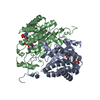 7dllC 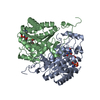 7dlmC 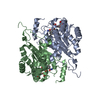 7dmgC 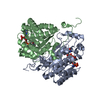 7dn1C 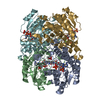 7vyqC C: citing same article ( |
|---|---|
| EM raw data |  EMPIAR-10872 (Title: Oligomeric interactions maintain active-site structure in a non-cooperative enzyme family EMPIAR-10872 (Title: Oligomeric interactions maintain active-site structure in a non-cooperative enzyme familyData size: 902.0 Data #1: Native-SCR-tetramer-frames [micrographs - multiframe]) |
- Links
Links
| EMDB pages |  EMDB (EBI/PDBe) / EMDB (EBI/PDBe) /  EMDataResource EMDataResource |
|---|
- Map
Map
| File |  Download / File: emd_32212.map.gz / Format: CCP4 / Size: 64 MB / Type: IMAGE STORED AS FLOATING POINT NUMBER (4 BYTES) Download / File: emd_32212.map.gz / Format: CCP4 / Size: 64 MB / Type: IMAGE STORED AS FLOATING POINT NUMBER (4 BYTES) | ||||||||||||||||||||||||||||||||||||
|---|---|---|---|---|---|---|---|---|---|---|---|---|---|---|---|---|---|---|---|---|---|---|---|---|---|---|---|---|---|---|---|---|---|---|---|---|---|
| Projections & slices | Image control
Images are generated by Spider. | ||||||||||||||||||||||||||||||||||||
| Voxel size | X=Y=Z: 0.837 Å | ||||||||||||||||||||||||||||||||||||
| Density |
| ||||||||||||||||||||||||||||||||||||
| Symmetry | Space group: 1 | ||||||||||||||||||||||||||||||||||||
| Details | EMDB XML:
|
-Supplemental data
- Sample components
Sample components
-Entire : Ternary complex of SCR with NADP and ethyl 4-chloroacetoacetate
| Entire | Name: Ternary complex of SCR with NADP and ethyl 4-chloroacetoacetate |
|---|---|
| Components |
|
-Supramolecule #1: Ternary complex of SCR with NADP and ethyl 4-chloroacetoacetate
| Supramolecule | Name: Ternary complex of SCR with NADP and ethyl 4-chloroacetoacetate type: complex / ID: 1 / Parent: 0 / Macromolecule list: all |
|---|---|
| Source (natural) | Organism:  Candida parapsilosis (yeast) Candida parapsilosis (yeast) |
-Macromolecule #1: Asymmetric Tetramer of SCR
| Macromolecule | Name: Asymmetric Tetramer of SCR / type: other / ID: 1 / Classification: other |
|---|---|
| Source (natural) | Organism: Candida parapsilosis |
| Sequence | String: S M G E I E S Y C N K E L G P L P T K A P T L S K N V L D L F S L K G K V A S V T G S S G G I G W A V A E A Y A Q A G A D V A I W Y N S H P A D E K A E H L Q K T Y G V H S K ...String: S M G E I E S Y C N K E L G P L P T K A P T L S K N V L D L F S L K G K V A S V T G S S G G I G W A V A E A Y A Q A G A D V A I W Y N S H P A D E K A E H L Q K T Y G V H S K A Y K C N I S D P K S V E E T I S Q Q E K D F G T I D V F V A N A G V T W T Q G P E I D V D N Y D S W N K I I S V D L N G V Y Y C S H N I G K I F K K N G K G S L I I T S S I S G K I V N I P Q L Q A P Y N T A K A A C T H L A K S L A I E W A P F A R V N T I S P G Y I D T D I T D F A S K D M K A K W W Q L T P L G R E G L T Q E L V G G Y L Y L A S N A S T F T T G S D V V I D G G Y T C P |
-Experimental details
-Structure determination
| Method | cryo EM |
|---|---|
 Processing Processing | single particle reconstruction |
| Aggregation state | particle |
- Sample preparation
Sample preparation
| Concentration | 3 mg/mL |
|---|---|
| Buffer | pH: 6 |
| Vitrification | Cryogen name: ETHANE |
- Electron microscopy
Electron microscopy
| Microscope | FEI TITAN KRIOS |
|---|---|
| Image recording | Film or detector model: GATAN K3 BIOQUANTUM (6k x 4k) / Number grids imaged: 1 / Number real images: 2885 / Average exposure time: 2.5 sec. / Average electron dose: 56.15 e/Å2 |
| Electron beam | Acceleration voltage: 300 kV / Electron source:  FIELD EMISSION GUN FIELD EMISSION GUN |
| Electron optics | Illumination mode: FLOOD BEAM / Imaging mode: BRIGHT FIELD / Nominal defocus max: 2.17 µm / Nominal defocus min: 1.37 µm / Nominal magnification: 105000 |
| Experimental equipment |  Model: Titan Krios / Image courtesy: FEI Company |
- Image processing
Image processing
| Startup model | Type of model: PDB ENTRY |
|---|---|
| Final reconstruction | Resolution.type: BY AUTHOR / Resolution: 4.03 Å / Resolution method: FSC 0.143 CUT-OFF / Software - Name: cryoSPARC / Number images used: 83948 |
| Initial angle assignment | Type: MAXIMUM LIKELIHOOD |
| Final angle assignment | Type: MAXIMUM LIKELIHOOD |
-Atomic model buiding 1
| Initial model | PDB ID: Chain - Source name: PDB / Chain - Initial model type: experimental model |
|---|---|
| Refinement | Space: REAL / Overall B value: 177 |
 Movie
Movie Controller
Controller


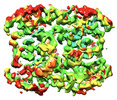


 Z (Sec.)
Z (Sec.) Y (Row.)
Y (Row.) X (Col.)
X (Col.)




















